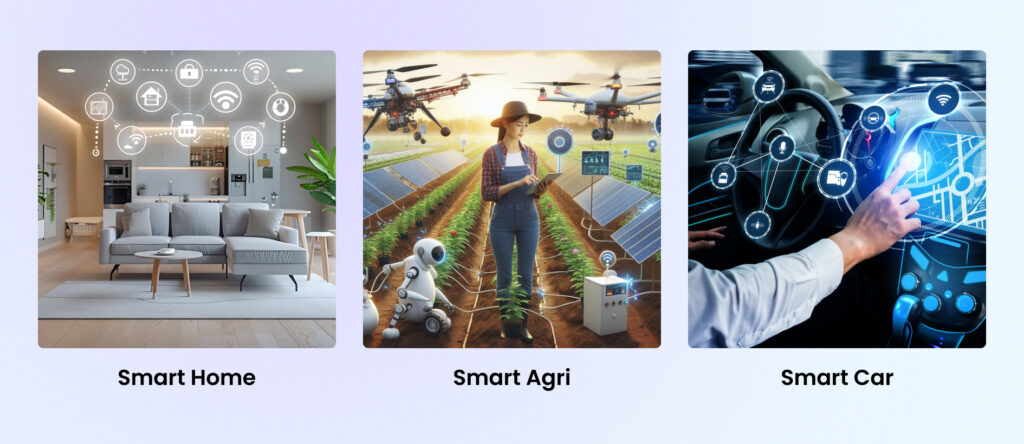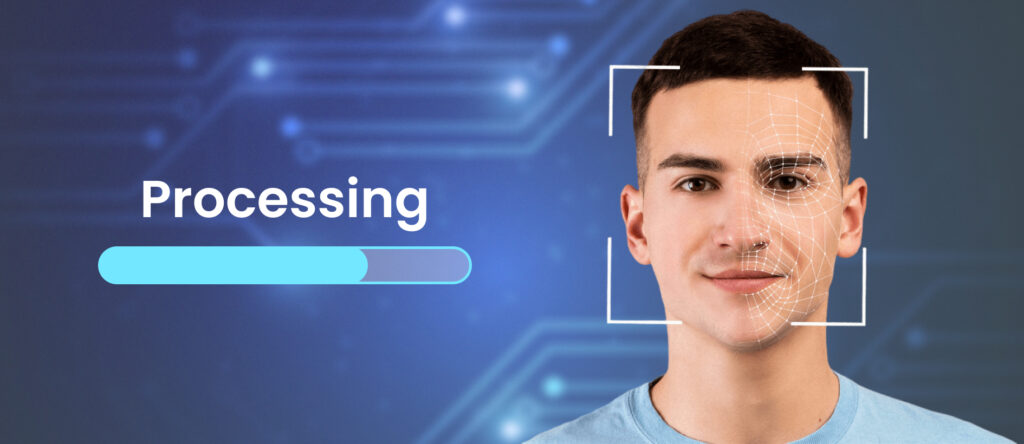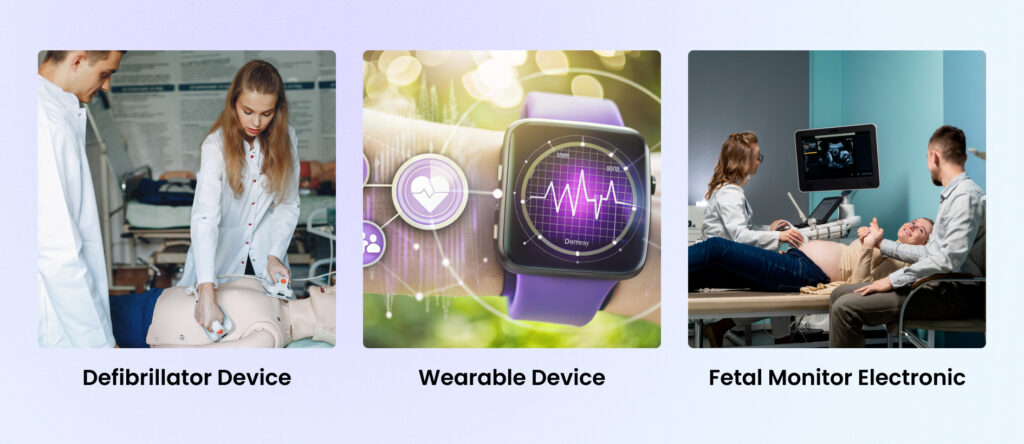Introduction
In our fast-paced society, innovation directly correlates with success. When it comes to significant advances, embedded systems are the unsung heroes that bring new ideas to fruition. Embedded systems have grown everywhere in a variety of sectors, transforming how humans interact with technology and defining modern life. Innovation in embedded systems is generating developments and improvements in a variety of sectors today.
An embedded system is a customized electronic device that performs specific duties or operations. It is often made up of a micro-controller or microprocessor, as well as additional components including ASICs (application-specific integrated circuits), FPGAs (field-programmable gate arrays), and DSPs (Digital Signal Processing). Unlike general-purpose devices such as laptops and smartphones, embedded systems are designed to perform specific jobs effectively.
Recent innovations in embedded systems have focused on integrating AI and machine learning directly into devices, enabling real-time data processing and decision-making at the edge. This has led to smarter IoT devices, enhanced automation in industrial applications, and advanced healthcare monitoring systems. Additionally, advancements in low-power micro-controllers and energy-efficient designs have extended battery life and reduced environmental impact.
In this blog, let us deeply understand about the Latest Innovations in Embedded System and How it works.
Greater IoT Integration
The Internet of Things (IoT) is a network of interconnected devices that easily communicate and share data over the internet. These devices can range from common household products like smart thermostats and refrigerators to industrial machines and wearables. The ability to collect, process, and analyze data in real time is essential for the Internet of Things, giving important insights and enhancing efficiency in a wide range of applications.
Embedded System and the Internet of things (IoT) share a foundation but differ in scope, connectivity, data handling, flexibility, security, and applications. IoT (Internet of Things) and embedded systems are intricately related, with embedded systems serving as the backbone of IoT devices. They provide power to sensors, processors, and actuators that collect data, process it, and act on data. For example, they manage communication protocols (such as Wi-Fi, Bluetooth, and Zigbee), which let devices to connect with one another or with larger networks.
Real-time applications that use IoT Integration

As we all know that IoT(Internet of Things) in today’s world is one of the most celebrated topics and is used to make life easier. The devices of IoT that connects our data to the devices are on a demand. So now we’ll discuss real-time IoT devices. The applications are as below.
Smart Homes: IoT technology allows several appliances and devices to communicate and interact with one another. This technology provides automation, convenience, and energy efficiency to your house. For example, Samsung’s SmartThings is an IoT based home automation system. It is used to control different kinds of devices remotely, including refrigerators, air conditioners, and washing machines.
Smart agriculture: IoT devices enable farmers to monitor and manage many of their crops and fields. The IoT can increase the productivity of agricultural people by automating operations. for example, GreenIQ uses smart sensors to track meteorological conditions and soil types in order to create the perfect irrigation strategy and adapting to environments.
Smart Cars: IoT has also given a huge change in the features of vehicles. Similarly, it is enhancing the growth of car companies as the demand is on a hike. In addition, connected cars or smart cars use the Dedicated Shortange communications(DSRC). it has an auto-maintenance and auto parking feature. For Example, Tesla is a driver-less car that uses IoT and AI to function. it performs tasks like handling the steering, changing the lanes, parking, etc.
The Future of IoT with BlueCoin: A New Era of Connectivity
As IoT technology develops, the combination of advanced IoT solutions like BlueCoin will play an important role in defining the future of smart environments. BlueCoin is a flexible IoT platform best for lots of applications, such as industrial automation and smart home systems. It blends Bluetooth Low Energy (BLE) technology with advanced sensors to collect, analyze, and transmission data in real time.
BlueCoin allows IoT systems to collect more precise and broadened data, resulting in to better decision-making. BlueCoin integration makes sure that data is reliable and up to date, whether it is used to track environmental conditions, assets, or energy consumption.
Edge Computing
Edge computing, which is sometimes referred to as Fog computing, is a distributed computing model and open information technology(IT) architecture. This paradigm drives computer data storage towards a location where it’s needed and enables mobile computing and IoT technologies. Edge computing drives applications, data, and computing power services away from centralized points and towards places that are closer to the user.
Why there is a Demand for Edge Computing?
Super-Fast Processing: While centralized cloud computing is unique in its own right, it often falls down when it comes to real-time data processing. Consider Edge computing, a decentralized strategy for bringing computing power closer to the data source. Edge Computing addresses a critical need for fast data processing by locating computing resources at the network’s edge, decreasing latency to milliseconds.
Low Latency: One of the main advantages of edge computing in embedded systems is its significant reduction in latency. Traditional cloud-based systems frequently face delays due to the round-trip time among the device and the cloud server. This latency is critical in applications that require real-time processing, like autonomous cars and industrial control systems.
Data privacy: Data privacy is a big issue in today’s digital world. Edge computing enables sensitive data to be processed and stored locally, providing more control over data privacy. Instead of transmitting data to the cloud, edge devices may perform complex computations and extract relevant insights at the edge, allowing greater protection for sensitive information.
The Role of Edge Computing in Autonomous Vehicle Decision-Making
In the rapidly expanding field of autonomous vehicles, the need for instantaneous data processing, ultra-low latency, and strict data protection has never been more critical. Autonomous vehicles work in a highly dynamic environment, where every millisecond counts. The latency created by sending data to distant cloud servers for processing can cause delays that are just intolerable when a vehicle must make split-second decisions.
Edge computing addresses this issue by decentralizing data processing, allowing critical computations to take place immediately within the vehicle or at nearby edge nodes. This decentralization enables data from the vehicle’s numerous sensors, like LIDAR, radar, and cameras, to be analyzed instantly. The end effect is a significant reduction in latency, allowing the vehicle to analyze its surroundings quickly, anticipate potential hazards, and perform complex maneuvers with precision. Such tasks as emergency braking, obstacle avoidance, and real-time route optimization.
Artificial Intelligence(AI) Revolution
Artificial intelligence (AI) technology allows computers and machines to simulate human intelligence and problem-solving tasks. The ideal characteristic of artificial intelligence is its ability to rationalize and take action to achieve a specific goal.
AI boosts embedded systems by adding smart decision-making. It helps these systems to process data, learn from it, and make choices on their own. This is important for self-driving automobiles, smart home devices, and factory robots. AI improves the accuracy and functionality of these devices by processing sensor data in real time. Combining embedded systems and AI results in smarter devices that can respond fast and predict problems before they occur.
Real-Time decisions Using AI
Predictive Maintenance: This aims to address these challenges by employing data-driven insights and AI algorithms to predict when maintenance or repairs are needed. For Example, Whispering Jets: The aerospace giant uses AI to analyze vast amounts of sensor data generated from jet engines during test runs. This enables them to predict potential issues and ensure the highest safety standards for their engines.
Surveillance and Security: The surveillance system is designed to analyze the video, image, and audio or any kind of surveillance data automatically without any human involvement. For Example, Video Forensics it is used for color conversion, regeneration, and comparison between two video backgrounds, which will help forensic teams to identify vehicles or objects during the post-incident investigation.
Autonomous driving: Autonomous driving technology uses AI and ML systems to read road conditions, traffic, and other inputs, and then make decisions about vehicle operation. For Example, this can be used as Path Execution in cars; after the path is planned, the vehicle can navigate the road conditions by detecting objects, pedestrians, bicycles, and traffic lights in order to reach the destination.
How Does Neural Network Facial Recognition Work?

A neural network is a method in artificial intelligence that teaches computers to process data in a way that is inspired by the human brain. Artificial Intelligence for security camera systems is becoming more and more commonplace, with AI-powered systems being used for everything from tagging friends in photos to unlocking phones and accessing buildings. But how does this technology actually work?
At its core, facial recognition relies on a dataset of tagged faces. This dataset is used to train the system to recognize patterns and features that are unique to each person. Once the system has been trained, it can then be used to identify faces in photos and videos, even if they are not clear or in profile. If it finds a match, the system sends an alert. But how does AI manage to recognize faces in difficult conditions? By identifying certain key features of a person’s face – such as the position of their eyes, nose, and mouth.
Security and Regulation
Embedded system security refers to concepts and techniques aiming at protecting software and hardware components from malicious actions and unauthorized data access. It encompasses such measures as data encryption, secure communication protocols, physical security, and secure boot processes. Before designing or redesigning embedded system architecture, it should be set up with a security policy to assess all potential risks and implement preventive measures in an early development stage.
As artificial intelligence (AI) continues to permeate various sectors, the intersection of data privacy regulations and cybersecurity has become a focal point of concern. The proliferation of AI applications, coupled with the increasing sophistication of cyber threats, underscores the necessity for robust security frameworks and stringent regulatory compliance.Cyber attackers can exploit vulnerabilities in AI systems to conduct data breaches, launch ransomware attacks, or even manipulate AI-driven decision-making processes. These threats necessitate the implementation of advanced security measures to safeguard AI systems and the data they process.
Modern Security Techniques Used in Embedded System
Secure Boot Process : Secure Boot is a process that ensures the integrity and authenticity of the software running on a device. It does this by verifying the digital signatures of the boot-loader, kernel, and other critical software components against trusted keys stored in the device’s firmware.
Robust Security: Robust encryption, authentication, and access control mechanisms should also be implemented. By adopting a multi-layered security strategy, organizations can increase the overall security of their embedded devices and improve their resilience against potential attacks.
Automated Monitoring Tools: Automated testing frameworks and tools are used in embedded systems to optimize testing procedures, boost productivity, and guarantee reliable test execution. This testing includes functional, performance, regression, and system testing, among other testing methods.
Embedded Systems in Home Automation
As our homes become smarter, the integration of embedded systems into home automation has skyrocketed. Devices like smart thermostats, security cameras, and voice-activated assistants offer convenience and control that were unimaginable a decade ago. However, with these advancements comes a growing concern: the security of these systems and the regulatory landscape that governs them.
Embedded systems are specialized computing devices designed to perform specific tasks within larger systems. In the context of home automation, these devices range from smart light bulbs that can be controlled remotely to complex security systems that monitor and protect your home 24/7. The key advantage of embedded systems lies in their ability to operate with minimal user intervention, making them ideal for automating repetitive tasks. However, this very feature autonomy can also be a vulnerability. As these devices operate largely independently, they become attractive targets for cyberattacks. This is where security measures and regulatory frameworks become crucial.
Healthcare and Wearables
Embedded systems have become integral components in the development of modern Healthcare devices. These systems, comprised of hardware and software designed for specific functions within a larger system, play a crucial role in enhancing the performance, accuracy, and reliability of medical devices used in healthcare settings.
Real-Time health monitoring device

Defibrillators : It is used to monitor a patient’s heart for irregular rhythms and gently shock the heart back into its normal rhythm when necessary, using embedded technology.
Wearable Devices : These devices are typically equipped with sensors that can monitor various physiological parameters such as heart rate, blood pressure, sleep patterns, activity levels, and more.
Fetal Monitor Electronic: Fetal heart monitoring is done during pregnancy, labor, and delivery to keep track of the heart rate of your baby (fetus) and the strength and duration of the contractions of your uterus.
How Embedded Systems in Smartwatches Are Transforming Healthcare?
Embedded systems are at the forefront of innovation in healthcare, playing a pivotal role in the development of wearable devices like smartwatches. These systems are crucial in enabling real-time data collection, analysis, and improving patient safety. As healthcare continues to evolve, smartwatches equipped with embedded systems are becoming indispensable tools for both patients and healthcare providers.
Real-Time Data Collection and Analysis
One of the key advantages of smartwatches is their ability to collect health data continuously. Embedded systems in these devices manage sensors that track vital signs such as heart rate, blood oxygen levels, and even ECG readings. The data is processed on the spot, providing immediate feedback to the user and helping users to make decisions about their activities, diet, and medication.
Enhancing Patient Safety
Embedded systems in smartwatches also play a crucial role in enhancing patient safety. Features like fall detection and emergency alerts are made possible through sophisticated algorithms running on these systems. If a user falls or experiences a sudden change in health status, the smartwatch can automatically send an alert to emergency contacts or healthcare providers, ensuring that help is dispatched quickly. Additionally, the ability to store and transmit health data securely is another safety feature powered by embedded systems.
Conclusion
The future of embedded systems is brimming with opportunities. As technology advances, the integration of software and hardware into devices and systems will become more intricate yet efficient, thanks to emerging technologies such as IoT, AI, and machine learning. However, concerns surrounding security and safety in embedded systems must be addressed to mitigate potential risks. With proper strategies and robust security measures, the benefits of embedded systems can be used in various industries.
| Serial No. | Related Blogs | Links |
|---|---|---|
| 1. | The Future Scope of Embedded Systems : Trends and Predictions | Click Here |
| 2. | Difference Between Embedded System and IoT | Click Here |
| 3. | The Future Of Intelligence At The Edge: Explore AI & ML With Emterxe | Click Here |
People Also Ask (PAA)
AI helps embedded developers by making testing, fixing problems, and making things better easier. But it probably won’t take their jobs. Making embedded systems needs special knowledge about how hardware and software work together, and AI can’t do that completely. Humans are still needed to make sure things work right.
With embedded systems, it is possible to replace dozens or even more of hardware logic gates, input buffers, timing circuits, output drivers, etc. with a relatively cheap microprocessor.
Wearable technology provides immense benefits to the healthcare and medical industry. It empowers organizations and people with personalized and real-time data accessibility. Whether it is patient care, healthcare management, fitness tracking, or athlete performance evaluation, wearable technology offers many benefits
